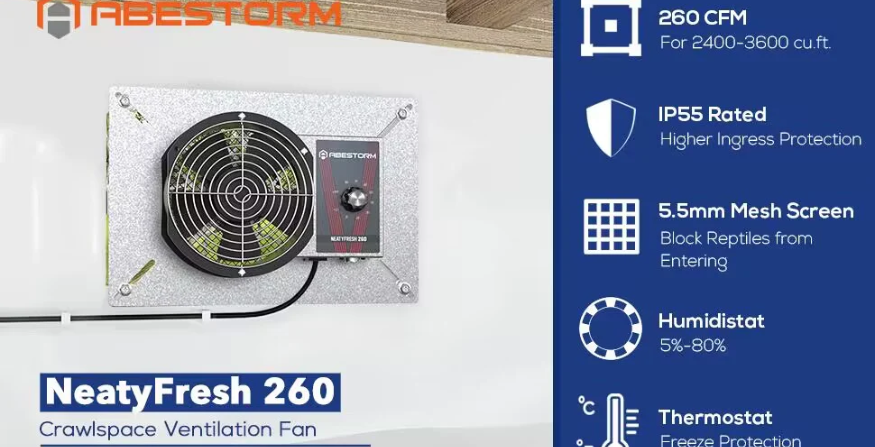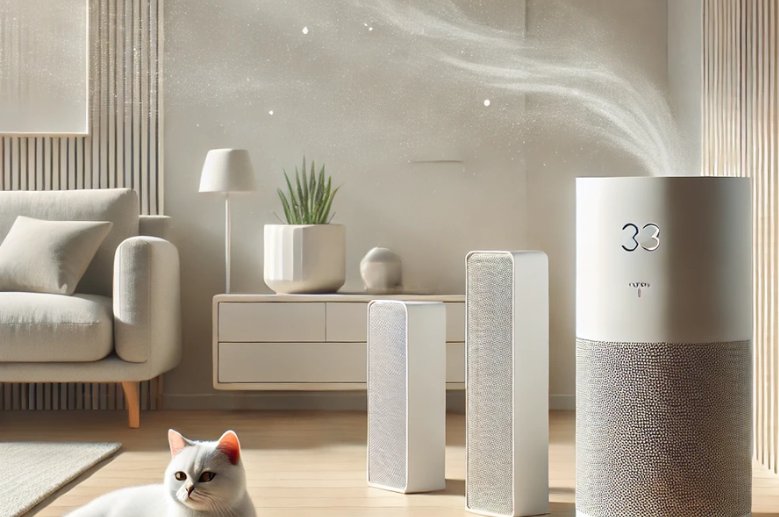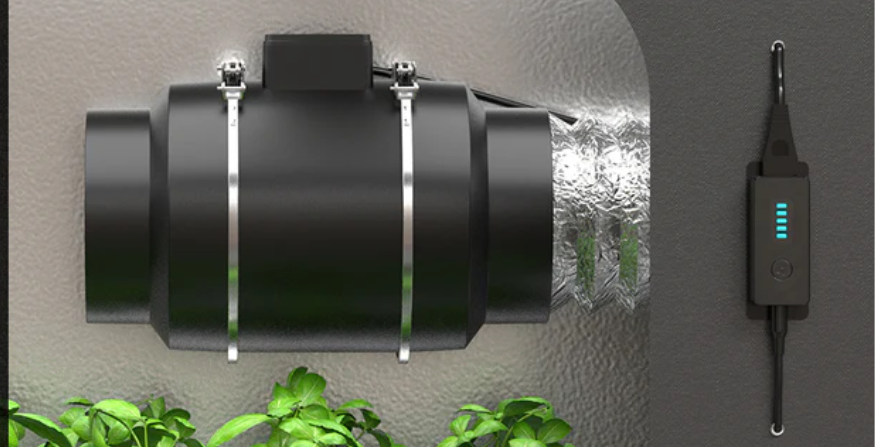Whether in the office or at home, we spend most of our time indoors, so it is important to keep indoor air fresh and comfortable. Poor air quality is not only harmful to our health but can also damage goods and property if it contains particulates like water vapors.
Ventilation fans ensure proper air circulation indoors and help avoid potential problems. There are different types of ventilation fans, each designed to serve different spaces. For instance, to remove stagnant air from a crawlspace, you need to use a crawlspace ventilation fan. Similarly, industrial fans can be used to remove harmful gases from factories.
Let’s look at the various types of ventilation fans and how they can help improve indoor air quality in different settings.
What are the Different Types of Ventilation Fans?
Here are different types of ventilation fans, how they work, and where they are commonly used:
1. Exhaust Fans
These are the common types of ventilation fans that remove stale, stagnant, moist, and polluted indoor air from an enclosed space and expel it outside. These are commonly used in kitchens, washrooms, and laundry rooms. Such types of fans such as kitchen exhaust fans and bathroom exhaust fans effectively neutralize bad odors like chemical smells, and cooking fumes, and reduce excessive moisture.
Since these fans keep the room fresh by sending moist and smelly air from a particular indoor space to the outside, they reduce humidity and help prevent mold growth. Typically, exhaust fans can be installed on windows, walls, and ceilings.
2. Supply Fans
Unlike an exhaust fan which expels indoor air, a supply fan brings fresh air from outside into the enclosed space where it is installed. It introduces fresh outdoor into the enclosed space and maintains positive air pressures. This keeps your indoor air fresh and comfortable.
These fans are widely used in commercial settings such as sealed offices, factories, cleanrooms, laboratories, and hospitals. Also, a supply fan is used in an HVAC system. An HVAC supply fan works alongside exhaust fans to ensure proper airflow.

3. Axial Fans
Axial fans ventilate air by moving it along the fan's axis. They use a propeller to move air. These fans are used in ventilation systems to move large volumes of air with minimal pressure difference. These are ideal for applications where high airflow is needed, but not high pressure, such as cooling towers, removing heat from data centers, or introducing fresh air in greenhouses.
These are used in both residential and commercial ventilation systems. These fans help keep the environment fresh by continuously circulating large amounts of air without significantly increasing pressure.
4. Inline Fans
These are special fans designed to be placed inside air ducts to help move air through long or complicated ventilation systems where traditional fans can’t be used. The inline fans increase airflow in areas that don’t have direct ventilation to the outside. They help move air from one room to another with the help of ducts.
An inline fan for ductwork can be used in areas where regular fans can't be installed or provide insufficient airflow, such as crawl spaces, basements, kitchens, or washrooms. These fans are typically hidden and operate quietly due to their location. They can also provide airflow to multiple rooms.
5. Centrifugal Fans
Centrifugal fans increase air pressure by moving air at a right angle from the intake. Unlike inline fans, centrifugal fans are used in areas where high pressure is needed. They spin the air as it enters the intake.
These fans, also called blowers, pull air in from the center and blow it out to the side to create high pressure. They are designed for industrial applications, such as factories and laboratories, where air needs to be moved through long duct systems.
6. Mixed Flow Fans
Mixed flow fans have features of both axial fans and centrifugal fans. This means they move air straight through the fan's axis but also produce high pressure like a centrifugal fan. This mixed operation allows these fans to handle large amounts of air over long distances while maintaining high pressure. This makes them an effective option for moving air longer distances.
These ventilation fan types can be used to meet versatile ventilation needs. Their applications include tunnels, subways, parking garages (garage exhaust fans), shopping malls, large-scale greenhouses, hospital HVAC systems, and many other commercial applications.
7. Cross Flow Fans
As the name suggests, these fans create a cross airflow, where the air moves across the fan's cylindrical blades. The air enters from one side of the blades and exits from the opposite side. These are called cross-flow fans because the airflow moves perpendicular to the fan's axis.
These fans are used in places where gentle and consistent air circulation is needed over a large area. Common applications include air heaters, air conditioners, and cooling systems for electronics.
8. Crawl Space Fans
These are a type of ventilation fan intended to ventilate and control humidity in crawl spaces. While these fans help reduce humidity, they can’t replace a humidifier if the conditions are too harsh. Crawl space fans create balanced airflow by drawing out stale and humid air and filling it with fresh outdoor air.
These fans help control humidity and mold buildup in crawl spaces by ensuring proper air circulation. These fans are a quiet and energy-efficient way to remove smelly, moist crawlspace air and reduce the risk of mold growth.

9. Ceiling Fans
These fans circulate the air in specific enclosed spaces or rooms. These are commonly used in homes and offices. They don’t remove air like exhaust fans. Instead, they circulate the air within the particular area they are installed in to create a cooling effect. They distribute the air evenly throughout the room by spinning their blades.
The main applications include bedrooms, living rooms, and offices to create a cooling or heating effect. They enhance your comfort by creating a cooling effect in summer and a heating effect in winter if used in reverse and reduce the energy consumption of your HVAC system. Typically, they come with reversible blades for seasonal use.
10. Attic Exhaust Fans
These fans are used to remove hot air from attics, especially during summer. Attics tend to get much hotter in the warmer seasons, and if this heat isn’t addressed in a timely manner, it can spread throughout your home, putting extra strain on your air conditioner. They work by venting out the hot air.
By cooling the attic space, these fans reduce the load on your air conditioning system which in return helps lower energy costs. They remove existing heat and prevent future heat buildup, which can damage your roof. Therefore, using an attic fan helps extend the lifespan of your roof.
11. Whole House Fans
Whole house fans are the most powerful types of ventilation fans designed to ventilate your entire home. They provide continuous fresh air circulation by pulling in fresh air from outside through windows and pushing stale indoor air outside through the attic.
This ventilation system for home is very helpful when the homes are located in cooler regions as it replaces existing indoor air with fresh outdoor air. So, when outdoor air is cooler, it can replace the traditional air conditioning system. They are most effective when the outdoor air is cooler than the indoor air. Therefore, the best times to use these fans are in the morning or evening.
Read this to find out the top 6 ventilation fans for bathrooms.
Conclusion
There are different types of ventilation fans, each engineered to serve a specific purpose. An exhaust fan helps remove stale indoor air from a particular room or space, whereas a whole-house fan ventilates your entire home. You can choose the one that best suits your needs.
Remember, whichever option you choose, these fans can help reduce moisture and improve air quality, but they can’t replace air purifiers and dehumidifiers in most cases.
If you are looking for a tailored solution to address your indoor air problems, you can visit our website or contact our support team. At Abestorm, our support team will help you find the best solution for your indoor air quality issues.









Shop For Dehumidifier